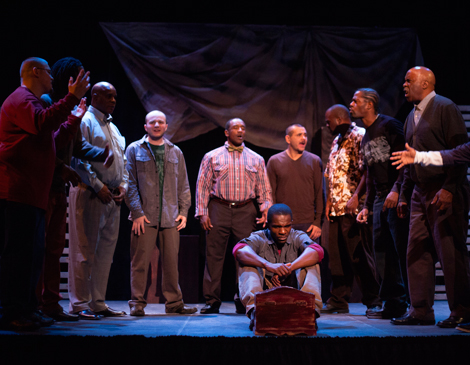The 14 men onstage are not trained actors. Months ago, some were living on the street; others were recovering from drug relapses or returning home after prison. But at the Y-Haven Theatre Project, their stories are the marquee event. Created in 1998 by Cleveland Public Theatre’s founder James Levin and executive artistic director Raymond Bobgan, the 14-week program brings together residents of Y-Haven, a transitional housing program from YMCA of Greater Cleveland, with CPT’s artistic staff to create a play based on the men’s experiences. A Q&A follows each one-act show, encouraging dialogues audiences might never otherwise begin. Though not strictly drama therapy, the program has proved a deeply transformative companion to Y-Haven’s counseling, providing a platform for the men’s stories while teaching job skills and interpersonal tools. As the project prepares for its 21st premiere Nov. 7, we went behind-the-curtain on four past productions.
Reconstruction of a Man (2000)
After spending two years directing workshop productions for Y-Haven’s staff, this was the first show Bobgan took on the road. The final play followed a man near death, who meets the different parts of himself on the path back to the living. “There’s this beautiful ending we wrote with the men, acknowledging ‘I can be the victim, but also the victimizer,’ ” says Bobgan. “It’s this accepting of the self — accepting the past with a vision toward the future.”
The Story of Baby20 (2009)
This dreamlike drama was born from a story circle, each actor adding one line to a tale. It started with the arresting image of a baby left on a doorstep, with only a tag reading “Baby20.” An old man must find the baby’s home. “This was their metaphorical way of describing the experience of recovery,” says Denis Griesmer, CPT’s CFO and general manager. “It’s this very rapid growing up and maturing you have to go through.”
Lost and Found (2011)
Diving into fraught father-son dynamics, this production drew everyone into the emotional fray. “I’m treating them like fellow artists. That respect means risking my own story, putting some of my own stuff out there,” says Bobgan. “There were themes inside that play, about families coming together for one person … that resonated with my heart. My heart was out onstage as well.”
What Is Inside (2014)
The cast made most of the set pieces in this play about the secrets inside a mysterious box. The plot came from “Directing Your Life” exercises, where participants direct actors in a scene plucked from their memory. “To see their ideas generate a story that’s bigger than the cast, to create something for the community,” says Adam Seeholzer, CPT’s education manager, “awakens a part of themselves they may have lost sight of.”




